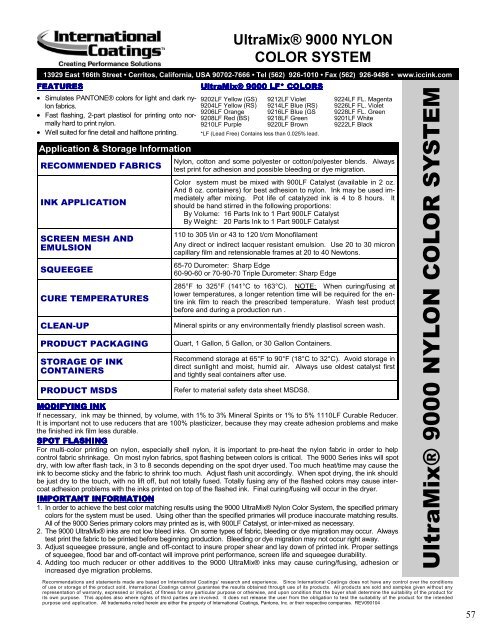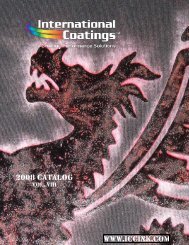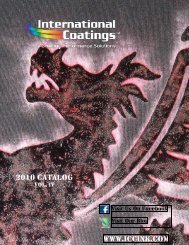2008 CATALOG WWW.ICCINK.COM
2008 CATALOG WWW.ICCINK.COM
2008 CATALOG WWW.ICCINK.COM
Create successful ePaper yourself
Turn your PDF publications into a flip-book with our unique Google optimized e-Paper software.
UltraMix® 9000 NYLON<br />
COLOR SYSTEM<br />
13929 East 166th Street • Cerritos, California, USA 90702-7666 • Tel (562) 926-1010 • Fax (562) 926-9486 • www.iccink.com<br />
FEATURE EATURE EATURES<br />
EATURE<br />
UltraMix® UltraMix® 9000 9000 LF* LF* COLOR COLORS COLOR<br />
� Simulates PANTONE® colors for light and dark ny- 9202LF Yellow (GS) 9212LF Violet 9224LF FL. Magenta<br />
lon fabrics.<br />
9204LF Yellow (RS) 9214LF Blue (RS) 9226LF FL. Violet<br />
9206LF Orange 9216LF Blue (GS 9228LF FL. Green<br />
� Fast flashing, 2-part plastisol for printing onto nor- 9208LF Red (BS) 9218LF Green 9201LF White<br />
mally hard to print nylon.<br />
9210LF Purple 9220LF Brown 9222LF Black<br />
� Well suited for fine detail and halftone printing. *LF (Lead Free) Contains less than 0.025% lead.<br />
Application & Storage Information<br />
Nylon, cotton and some polyester or cotton/polyester blends. Always<br />
RE<strong>COM</strong>MENDED FABRICS test print for adhesion and possible bleeding or dye migration.<br />
Color system must be mixed with 900LF Catalyst (available in 2 oz. SYSTEM<br />
And 8 oz. containers) for best adhesion to nylon. Ink may be used immediately<br />
after mixing. Pot life of catalyzed ink is 4 to 8 hours. It<br />
INK APPLICATION<br />
should be hand stirred in the following proportions:<br />
By Volume: 16 Parts Ink to 1 Part 900LF Catalyst<br />
By Weight: 20 Parts Ink to 1 Part 900LF Catalyst<br />
110 to 305 t/in or 43 to 120 t/cm Monofilament<br />
SCREEN MESH AND<br />
Any direct or indirect lacquer resistant emulsion. Use 20 to 30 micron<br />
EMULSION<br />
capillary film and retensionable frames at 20 to 40 Newtons.<br />
65-70 Durometer: Sharp Edge<br />
SQUEEGEE<br />
60-90-60 or 70-90-70 Triple Durometer: Sharp Edge COLOR<br />
285°F to 325°F (141°C to 163°C). NOTE: When curing/fusing at<br />
lower temperatures, a longer retention time will be required for the en-<br />
CURE TEMPERATURES tire ink film to reach the prescribed temperature. Wash test product<br />
before and during a production run .<br />
CLEAN-UP<br />
Mineral spirits or any environmentally friendly plastisol screen wash.<br />
PRODUCT PACKAGING Quart, 1 Gallon, 5 Gallon, or 30 Gallon Containers.<br />
Recommend storage at 65°F to 90°F (18°C to 32°C). Avoid storage in<br />
STORAGE OF INK<br />
direct sunlight and moist, humid air. Always use oldest catalyst first<br />
CONTAINERS<br />
and tightly seal containers after use.<br />
NYLON<br />
PRODUCT MSDS<br />
Refer to material safety data sheet MSDS8.<br />
MODIFYING MODIFYING INK<br />
INK<br />
If necessary, ink may be thinned, by volume, with 1% to 3% Mineral Spirits or 1% to 5% 1110LF Curable Reducer.<br />
It is important not to use reducers that are 100% plasticizer, because they may create adhesion problems and make<br />
the finished ink film less durable.<br />
SPOT SPOT SPOT FLASHING<br />
FLASHING<br />
9000<br />
For multi-color printing on nylon, especially shell nylon, it is important to pre-heat the nylon fabric in order to help<br />
control fabric shrinkage. On most nylon fabrics, spot flashing between colors is critical. The 9000 Series inks will spot<br />
dry, with low after flash tack, in 3 to 8 seconds depending on the spot dryer used. Too much heat/time may cause the<br />
ink to become sticky and the fabric to shrink too much. Adjust flash unit accordingly. When spot drying, the ink should<br />
be just dry to the touch, with no lift off, but not totally fused. Totally fusing any of the flashed colors may cause intercoat<br />
adhesion problems with the inks printed on top of the flashed ink. Final curingIfusing will occur in the dryer.<br />
IMPOR IMPORTANT IMPOR TANT INFORMATION<br />
INFORMATION<br />
INFORMATION<br />
1. In order to achieve the best color matching results using the 9000 UltraMix® Nylon Color System, the specified primary<br />
colors for the system must be used. Using other than the specified primaries will produce inaccurate matching results.<br />
All of the 9000 Series primary colors may printed as is, with 900LF Catalyst, or inter-mixed as necessary.<br />
2. The 9000 UltraMix® inks are not low bleed inks. On some types of fabric, bleeding or dye migration may occur. Always<br />
test print the fabric to be printed before beginning production. Bleeding or dye migration may not occur right away.<br />
3. Adjust squeegee pressure, angle and off-contact to insure proper shear and lay down of printed ink. Proper settings<br />
of squeegee, flood bar and off-contact will improve print performance, screen life and squeegee durability.<br />
4. Adding too much reducer or other additives to the 9000 UltraMix® inks may cause curing/fusing, adhesion or UltraMix®<br />
increased dye migration problems.<br />
Recommendations and statements made are based on International Coatings’ research and experience. Since International Coatings does not have any control over the conditions<br />
of use or storage of the product sold, International Coatings cannot guarantee the results obtained through use of its products. All products are sold and samples given without any<br />
representation of warranty, expressed or implied, of fitness for any particular purpose or otherwise, and upon condition that the buyer shall determine the suitability of the product for<br />
its own purpose. This applies also where rights of third parties are involved. It does not release the user from the obligation to test the suitability of the product for the intended<br />
purpose and application. All trademarks noted herein are either the property of International Coatings, Pantone, Inc. or their respective companies. REV090104<br />
57




